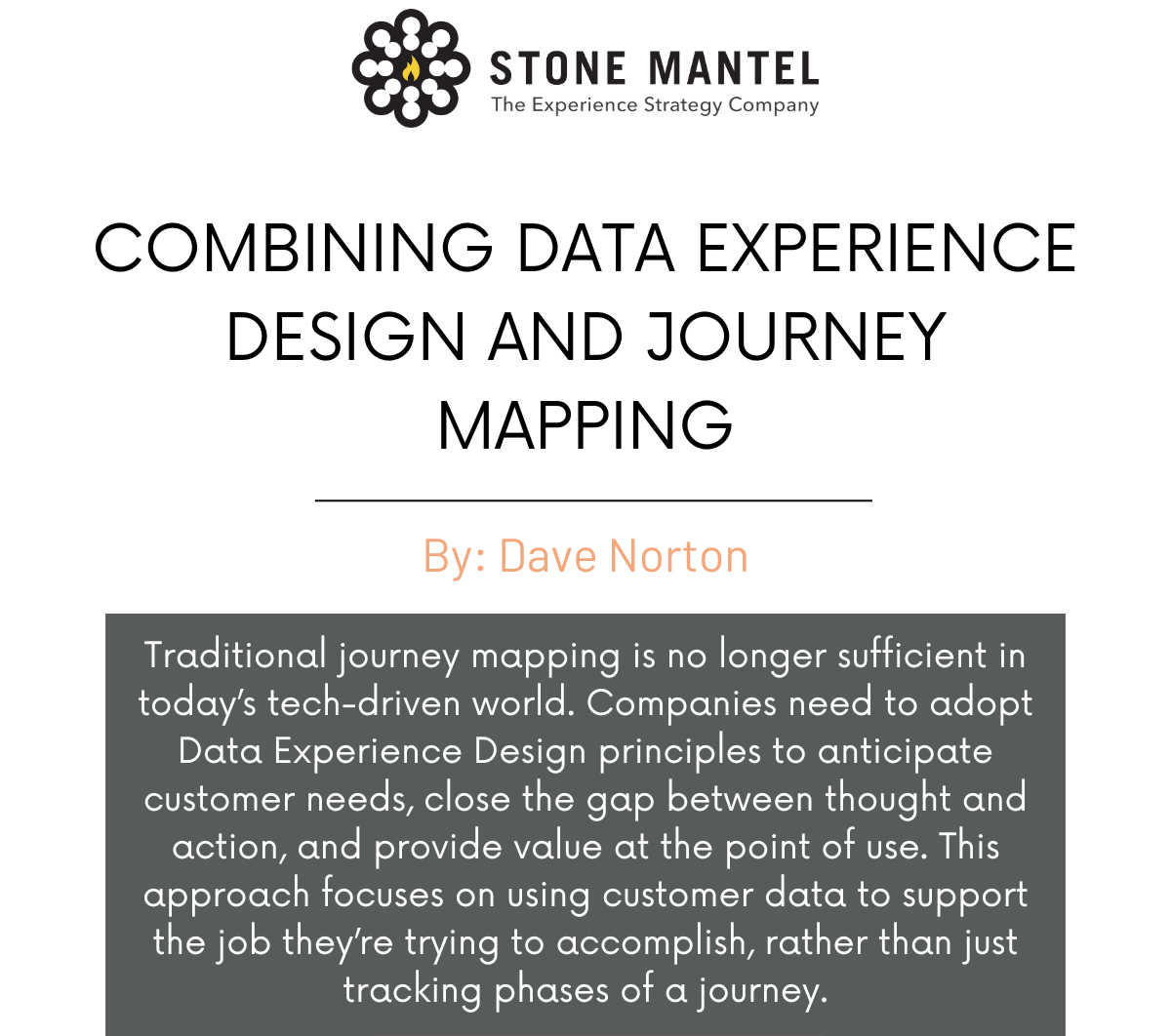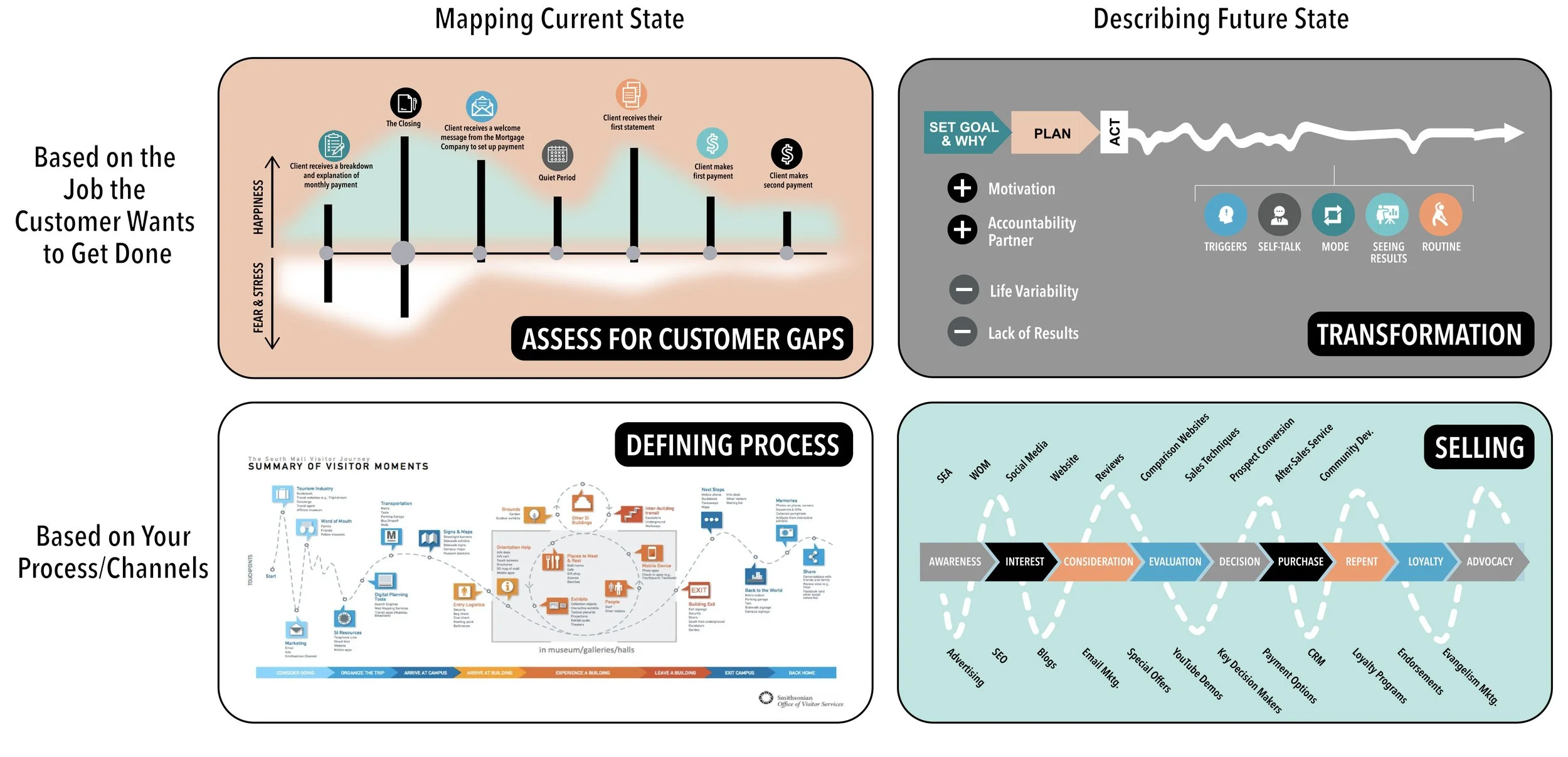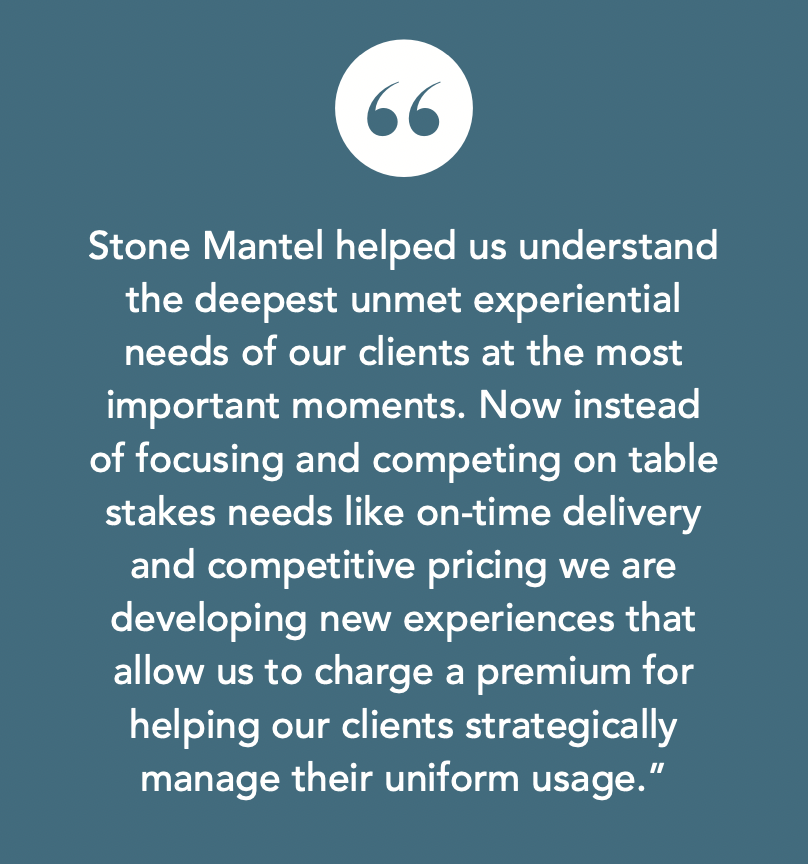Stone Mantel Experience Strategy Blog
Experience Strategy Podcast: The Power of Situational Markets in Experience Strategy
In the latest episode of The Experience Strategy Podcast, we’re dismantling traditional market segmentation and rebuilding it with the revolutionary concept of situational markets. Dave Norton, our experience futurist, gives us a sneak peak into his upcoming book that’s set to redefine how we create value. Joined by industry veteran John Gusiff, we discuss the power of jobs-to-be-done research, the limitations of demographic-based personas, and the critical importance of understanding evolving customer needs. From leveraging qualitative data to scale situational strategies, to anticipating your customers’ future selves, this episode is packed with game-changing ideas for forward-thinking experience strategists.
Will customers of the future create their own journey maps?
The world is changing fast, and so are the ways customers approach personal transformation and growth. Your job is not just to respond to customer needs; it's to anticipate them. It's to 'skate to where the puck will be.'
We're seeing a shift in how customers approach their journeys with companies. They're becoming more self-aware, more intentional about their goals, and more cognizant of their expectations and preferences. This shift is leading us to an intriguing question: Are we heading towards a future where customers create their own journey maps?
Experience Strategy Podcast: Enhancing Customer Experiences with Driving Business Value with AR/VR
In this episode of The Experience Strategy Podcast, hosts Dave Norton and Aransas Savas sit down with AR/VR trailblazers Spencer Cook from Continuum, and Bryan Searing of Stone Mantel to explore the transformative power of Augmented Reality and Virtual Reality in crafting captivating customer experiences. Fresh off the Experience Strategy Collaboratives program, where cutting-edge AR/VP concepts were tested with real customers, Spender and Bryan share exclusive insights ad real-world case studies that demonstrate the immense potential of these technologies in driving business growth.
Tune in and gain:
Actionable strategies for leveraging AR/VR to create immersive, memorable customer experiences
A deep understanding of how AR/VR are reshaping the future of experience design and marketing
Practical takeaways and best practices for successfully integrating AR/VR into your organization’s strategy.
How Journey Maps Can Make Customer Experiences More Valuable?
In the fast-evolving world of customer experience (CX), understanding the intricacies of the customer journey is crucial for creating meaningful and valuable interactions. Journey maps, which visualize the steps customers take as they interact with a company, are indispensable tools for experience strategists and CX professionals. They not only highlight areas for improvement but also help in aligning business objectives with customer jobs to be done (needs that customers are willing to pay you to do for them or help them with). This article delves into how journey maps can enhance customer experiences by using journey maps to align on how to deliver three distinct types of time that customers value: time well saved, time well spent, and time well invested.
What Do You Include in a Future-Focused Journey Map?
In another post, I showed that there are four common types of journey maps. There are maps that describe current gaps in the experience; ones that define internal processes; others that are designed for generating sales. And then there are journey maps that are designed to describe a future-state experience. Many companies confuse the first three for the last. They hope that the act of creating a journey map will yield a strategy for the future.
Experience Strategy Podcast: Situational Markets and Employee Experiences with Steve Usher of The Experience Designers Podcast
In this episode of the Experience Strategy Podcast, we are joined by special guest @Steve Usher, founder and host of The @Experience Designers Podcast. We go deep into the core principles that drive success in experience strategy across both customer and employee offers. We challenge the status quo, pushing beyond played-out persona-based segmentation to explore the untapped potential of situational markets and context. Tune into this episode (at the link in the comments). It’s time to zoom out, see the big picture, and take full responsibility for executing on the complete job to be done.
Combining Data Experience Design and Journey Mapping
As I have mentioned in other articles in our newsletter, journey mapping must change to address the realities of today’s customer-centricity. We work in a very different business environment today. Generative AI is changing how people interact with products. Augmented and Virtual Reality is burgeoning. Technology, in general, is exploding.
Experience Strategy Podcast: The Keys to Employee Engagement with the RecogNATION Podcast
In this episode, we jam with Neely Adkins and Kailey Savona from the RecogNATION Podcast. As fellow experience nerds focused on the employee side, we discuss the importance of celebrating milestones and micro-moments in the employee journey, emphasizing how vital it is to make every employee feel valued, connected, and heard. The key takeaway? In a world of increasing AI and automation, empathy and human connection will be true differentiators, and as experience strategists, our role is to champion and scale those human-centric cultures.
Get Personal by Pairing a Journey Map with a Mode Map
Companies are so used to thinking about the customer’s experience as a journey that they miss the greatest opportunity to personalize the customer’s experience. The reality of what the customer is doing right now is the most important opportunity and with a mode map, companies can be prepared for the customer’s now.
The Journey Should Follow the Job to be Done
Journey mapping has become a farce. And that’s a big problem for experience strategists. By building on problematic personas, company-centric stages, and cumbersome channels, strategists have turned the once king of customer-centric design, the journey map, into the court jester.
The typical approach that most companies follow is to start by creating a persona, a representation of the buyer/user that often includes segmentation data, then design a journey map, that shows how the persona experiences the solution. The journey maps are typically made up of stages that customers experience. The personas and journey maps help companies to solve for complex delivery issues that grow out of their channel strategies.
Experience Strategy Podcast: Experience Strategy in the Educational Journey with the Founders of [YELLOWCAR]
In this episode of the Experience Strategy Podcast, we’re joined by Dr. David Willows and Suzette Parlevliet, co-founders of [YELLOW CAR], the world’s leading experience strategy and consultancy firm for schools. David and Suzette share their insights on transforming education through the lens of experience strategy, discussing the unique challenges and opportunities in the international school landscape. They introduce the Felt Experience Indicator, a tool developed by [YELLOW CAR] to help schools measure and understand the experience of their community members, fostering a culture of listening, feedback, and continuous improvement. With their diverse backgrounds and dedication to making experience strategy accessible to schools worldwide, David and Suzette are committed to helping educational institutions align mission, experience, and impact, ultimately redefining success and creating meaningful value propositions that resonate with their target audiences.
Developing a Growth Strategy for Situational Markets - Article
The way that strategists think about their customer markets is based on the outdated idea that each person represents a unit within a market. Today, many companies still use terms like ‘mass market’, or ‘all the people are customers’ strategy, and ‘segmentation’ strategies, which means ‘only certain types of people’ are our customers. When companies define a ‘market’ as a certain number or type of customer, they put artificial constraints on their solutions, with the most glaring being that certain solutions are only for certain people. These constraints hinder innovation and limit growth.
Experience Strategy Podcast: Bringing CX to Associations and Membership Organizations with Brian Edwards, CP of Membership at AAFP
In this episode of the Experience Strategy Podcast, we’re joined by Brian Edwards. VP of Membership at the American Academy of Family Physicians (AAFP), to explore the unique challenges and opportunities of applying customer experience strategy within associations and membership-based organizations. Brian shares his insights on establishing common ground around the mission to navigate the complex governance structures, developing a segmentation approach that honors members’ needs at different stages, looking outside the association space for inspiration on retaining members and driving satisfaction, and using experience management frameworks to prioritize initiatives and focus on core competencies. With his extensive background in customer experience and operations leadership, primarily in the healthcare industry, Brian brings a wealth of knowledge and a passion for continuously improving the experiences of those around him.
Experience Strategy Podcast: The Future of Behavior Change: How Suggestic is Transforming Wellness Journeys
In this episode of The Experience Strategy Podcast, we are thrilled to chat with Victor Chapela, co-founder and CEO of Suggestic, who shared how they are leveraging AI and data to dramatically rethink the intersection of lifestyle journeys and wellness. Tune in to this episode for Victor’s key insights:
Focusing on what people can do realistically do vs. what they should do to minimize friction
Tapping into extrinsic motivation by allowing people to share progress.
Using AI interfaces like LLMs as a universal UI to collect data, model behaviors, and provide personalized guidance.
The power of making something extremely difficult much easier to drive adoption and impact.
This conversation exemplifies the importance of centering journeys on an individual’s unique goals and solutions, and provides a valuable model for using AI responsibly to enable personalized behavior change - leaving us energized about the implications for experience strategy across different industries.
What’s Still Missing From Hyperpersonalization Strategies
People Want Customized Retail Experiences
Retail experiences that are customized to individuals are an absolute must today. People will not tolerate retailers that don't remember purchases, provide tailored recommendations, and understand preferences. Many retailers refer to this kind of activity as personalization.
In most cases, people want more ability to customize their experiences, and some companies have referred to this as hyperpersonalization. But when we talk to consumers, we hear something very different.
Defining Customer Journey Mapping: Make Your Journey Maps Useful Again With a Few Simple Questions
One of the greatest things that experience strategists have done to transform companies into customer-centered businesses is to invent the journey map, but now, thanks to their pervasiveness, journey maps have become problematic in many organizations.
Next Generation Consumerization in Healthcare
There is a substantial shift in health “ownership” happening in the healthcare industry, driven both by consumers’ increasing interest in taking charge of their health and soaring healthcare costs. Consumers driving this shift have notably different expectations from those of healthcare companies. At the same time, the entire consumer healthcare audience continues to be influenced by their experiential interactions outside the healthcare space, which is driving demand for similarly-calibered experiences within healthcare.
All healthcare companies must focus on these critical changes. Many adopt CX practices such as personas in hopes of addressing the ever-evolving needs of their patients, customers, and employees. Unfortunately, most persona work does not address the ever-evolving expectations of patients, customers, or employees.
For healthcare companies to succeed in driving growth, they must enhance customer and patient experiences to better align with audience expectations. Next-generation experience strategies are the key to accomplishing this. These strategies start with understanding the common situations that patients and customers encounter and developing techniques that turn these situations into opportunities for both the company and the customer.
Case Study: Innovating To A Better Value Proposition
G&K Services, a branded-identity uniform rental and direct-sales company, found itself losing customers to larger, more aggressive firms such as Cintas as the uniform business became more price-driven and less value- and service-focused. The team at G&K needed to find new ways to enhance their value proposition to current and future customers—or risk continuing to lose ground against the “big guys.
Experience Strategy Podcast: Unlocking the Customer Value Chain
In today’s episode, we had the privilege of speaking with Thales Teixeira, a leading expert on customer-focused innovation. Thales is the co-founder of Decoupling and the author of “Unlocking the Customer Value Chain: How Decoupling Drives Consumer Disruption”
Our discussion with Thales is a succinct masterclass in unlocking customer value by focusing on what matters most - money, time, and effort. We discussed how disruptive startups gain traction by decoupling and excelling at key value-creating activities while avoiding “value eroders” that waste customers’ precious currencies. Thales brought this concept to life by breaking down companies like @Netflix eliminating the hassle of going to the video store, and @Alibaba layering on services like payments to make shopping smoother. Whether an innovative startup or an established organization, prioritizing your roadmap to remove friction and create more time well spent is crucial for delighting your customers and staying ahead of disruptors.
Experience Strategy Podcast: How Empathy Can Save Your Business with Dr. Natalie Petouhoff
Dr. Natalie Petouhoff is the author of the award-winning WSJ best-selling book Empathy in Action. She guides brands to see empathy as a business construct that helps them reduce costs and increase value because they are delivering great customer and employee experiences.
In this episode of The Experience Strategy Podcast, we explore the transformative power of empathy and its crucial role in shaping exceptional experiences for employees and customers.
Check out Dr. Petouhoff’s book here. To dive deeper into the world of creating memorable experiences that drive customer loyalty and growth, follow Joe Pine and read his groundbreaking book, The Experience Economy.












![Experience Strategy Podcast: Experience Strategy in the Educational Journey with the Founders of [YELLOWCAR]](https://images.squarespace-cdn.com/content/v1/613289e53dda745d13a61433/1717514123032-KW52AFB586U3GJ5ZIZ0S/Experience+Strategy+%2811%29.png)








